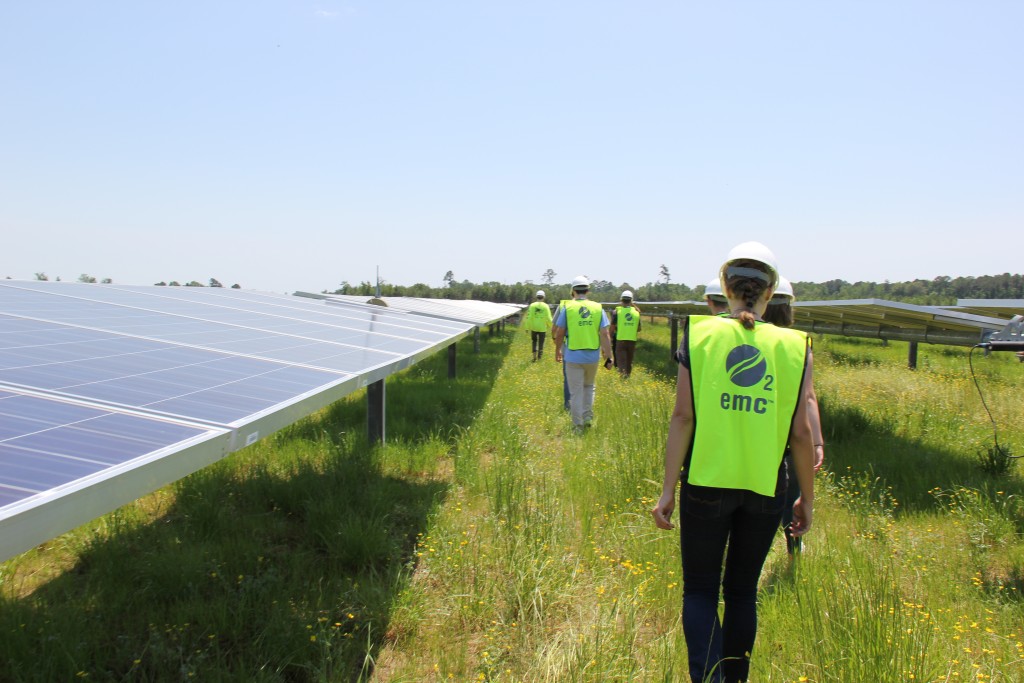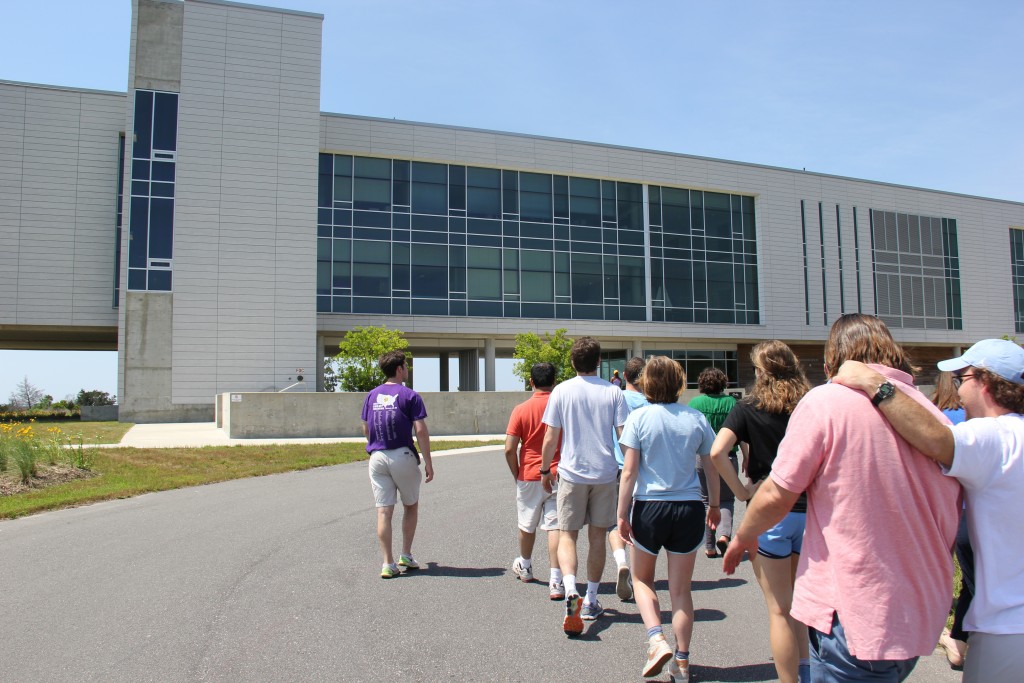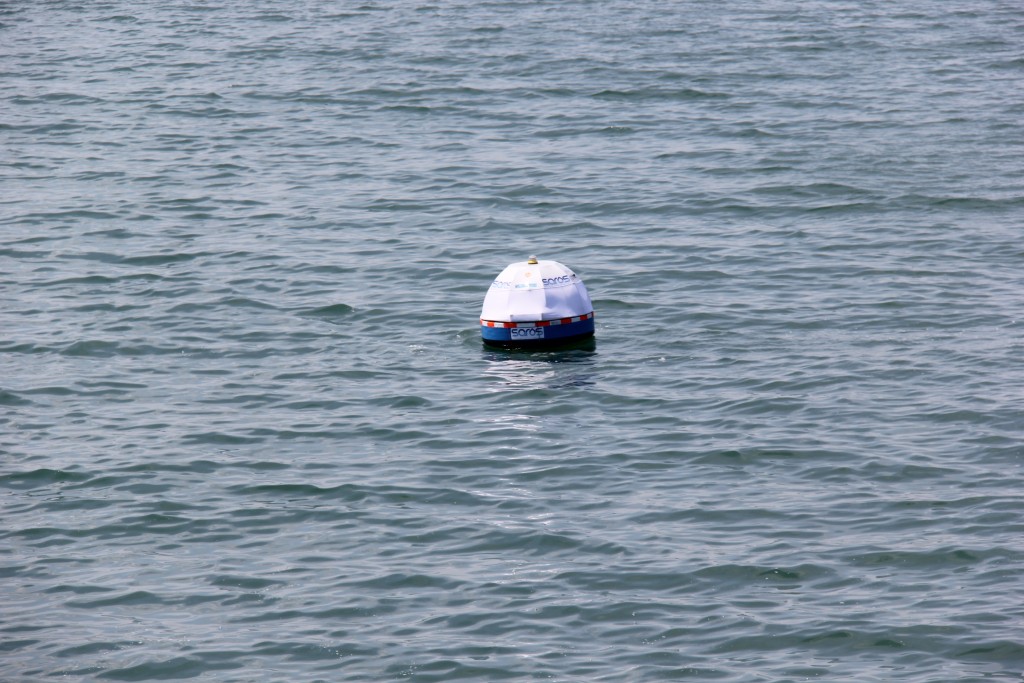Taking the classroom into the field, UNC-Chapel Hill course delves deep into NC’s renewable energy future
July 11, 2016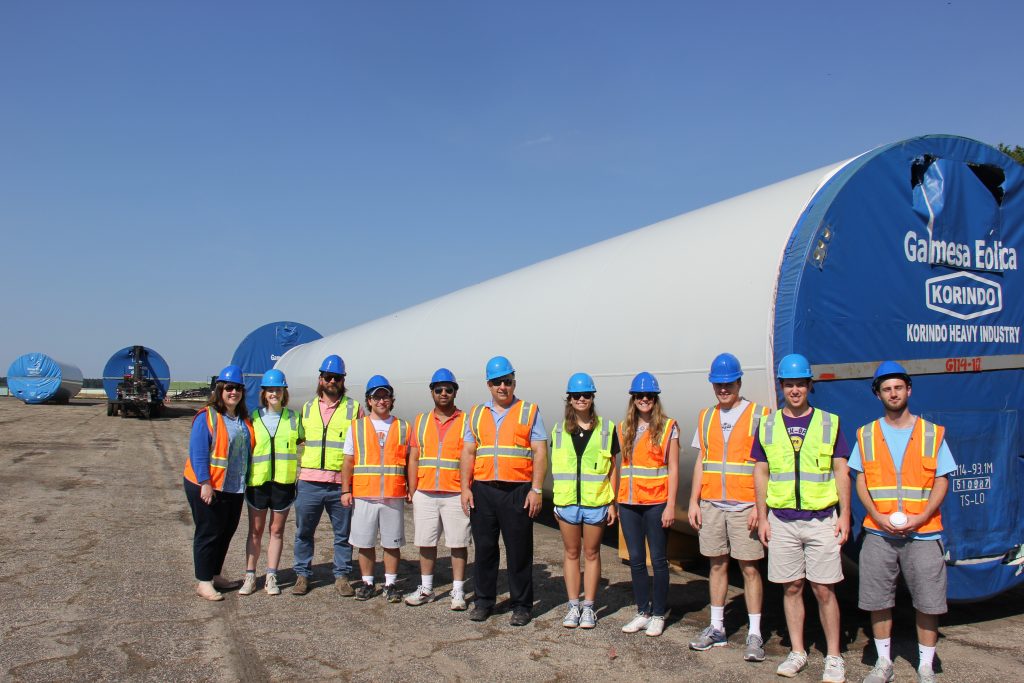
The class in front of a turbine base at the Amazon Wind Farm
Stepping inside the base of a 500-foot, two-megawatt wind-turbine, is something most people can’t say they’ve experienced, unless they’ve taken Professor Greg Gangi’s course on the future of energy.
Gangi, associate director for education at the Institute for the Environment and environmental studies professor at UNC-Chapel Hill, spent the beginning of his summer break in the classroom with nine students studying changes in renewable energy with a focus on new technologies, policies and financing. The course wrapped up with a trip to Strata Solar and various sites in Eastern North Carolina to apply what the students learned to the local renewable energy sector.
The inspiration for developing this course came from an understanding of how large an impact energy has and how rapidly energy is changing, Gangi explained.
“The way we get our electricity has been set in stone for almost hundred years: large power plants, distribution lines, customers buying from a large investor,” Gangi said. “Now, there is so much change going on at every level from the production of new technology, distribution of energy, ways of managing the grid. So that’s one part of it.
“The other part is that it is so important in our lives, like in public health and how energy choices effect how people develop acute respiratory problems. It’s also important when it comes to issues of poverty. If you’re poor you might be spending a huge chunk of your income on electricity and it’s really an obstacle to people climbing out of poverty.”
Throughout the semester Gangi invited various guest speakers to address the class. The speakers included Environmental Science Professor Jordan Kern, Executive Director of the North Carolina Sustainable Energy Association Ivan Urlab, Associate Vice Chancellor for Campus Enterprises Brad Ives, and the President of Southeast Wind Coalition Katharine Kollins.
Sophie Dockstader, an environmental science and economics double-major and entrepreneurship minor, said the speakers helped prepare the students for their trip to the coast.
In late May, the class took a field trip to Strata Solar where they met with Markus Wilhelm, the founder and CEO of Strata. At Strata the class discussed renewable energy financing, using Strata to focus on the financing of one of the largest solar developers in the country.
Next the class traveled to Eastern North Carolina where they visited several different sites, including the Roanoke Electric Cooperative, a O2EMC, the Amazon Wind Farm, the Pasquotank Public Safety Building, the UNC Coastal Institute, and Jennette’s Pier.
The Roanoke Electric Cooperative, located in the rural town of Aulander, sticks out due to its size, futuristic look, and the rows of solar panels sitting in front of the building.
There, the class met Susan Trent, manager at the cooperative, who talked about what the organization is doing to become a trailblazer in energy efficiency. The Roanoke Electric Cooperative functions as a member-owned non-profit organization that promotes education, training and member involvement to ensure each member receives reliable and affordable energy.

The Roanoke Electric Cooperative uses their “Upgrade to $ave” program and community solar to promote energy efficiency and renewable energy. Tann talked about the initial focus being on reducing energy consumption.
“As long as the house is what we consider a ‘healthy home’, one that can be upgraded, we will try to get them some funds or loan to get the house to a standard where we can go in and do the energy efficiency upgrades.” Tann said. “It might be a heat pump, it might be insulation. Then they are able to pay that back through their liability without having to pay anything out of pocket.”
The community solar project at Roanoke Electric Cooperative allows member-owners to purchase solar panels for a down payment of $162 and pay $1.88 per month on their bill until they pay off the total cost of $465. Each month credit comes off the owner’s electricity bill. The panels are located outside the Roanoke Electric Cooperative building.
Tann said that the community-feel of the cooperative means that employees are never off duty. So when a customer approaches them with a question about their energy bill at a local store or shows up at their front door, employees are equipped with brochures and handouts and are expected to help.
Parv Aggarwal, incoming MAT graduate student with a concentration in physics, said he was very impressed with the community attitude Roanoke Electric Cooperative shared with its member-owners.
“Visiting Roanoke Electric co-op was an eye opening experience,” Aggarwal said. “We learned about the pioneering initiatives they are undertaking in both community solar production and home energy efficiency upgrades. It was also dazzling to hear that all their employees are always ‘there’ to explain their programs to the community/customers even in their personal time despite it being a non-profit revenue sharing venture.”
The next stop was an O2EMC Solar Farm partnered with Sun Raised Solar Farms in Eure where the class met with Kelly Hendley and Logan Stephens from O2EMC to talk about logistics and affect of Sun Raised Solar Farms.
The expansive solar farm sat behind a quaint brick house, which Stephens said belonged to the couple that sold them the land for the solar farm. Stephens said the couple was thrilled with the project and proud to have been part of the process.
The panels, which were spread out in an organized fashion, were absent from areas that contained wetland shrubbery or trees. Stephens said that they did this to maintain the original integrity of the land.
Sun Raised Solar Farms are built upon a symbiotic relationship between the solar farm and sheep farmers, Hendley said. The fenced-in solar farm provides a safe area for sheep farmers to raise hormone and pesticide free sheep, while the sheep graze and maintain the grass beneath and around the solar panels.
Although there were no sheep at this site yet, Hendley talked about the benefits of having sheep on the solar farm.
“We partner heavily with a group called Sun Raised Farms,” Hendley said. “In order to avoid several things we like to have sheep on the site. The first thing is avoiding mowing. This is still a young site so were trying to ensure that we can sustain the sheep which is part of why its not fully populated yet. Mowing can cause flying rocks, which is dangerous to the equipment. Also, we like to keep all the farmland in North Carolina as agricultural as we can. The other thing is that we try to use as little of herbicides as we can for the environment as well.
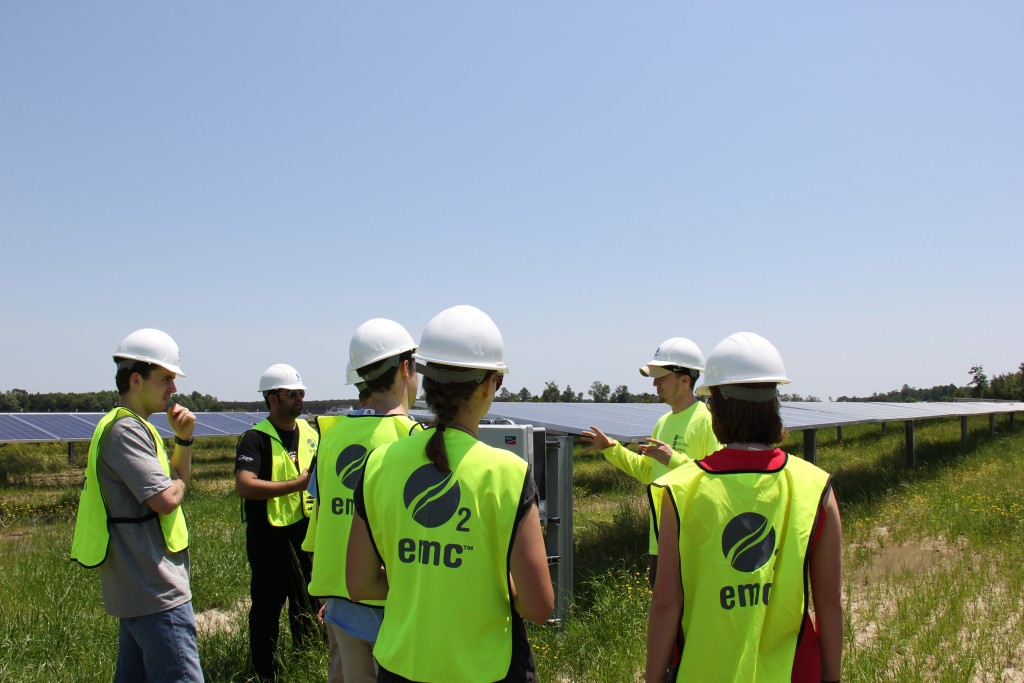
“So the sheep hit a lot of our check boxes as far as what we think are good practices. We also push and try to get others in the industry to follow along.”
Stephens said this Sun Raised Solar Farm was commissioned last December and is the eleventh solar farm for Sun Raised Solar Farms.
The Amazon Wind Farm, located in Elizabeth City, was the next stop for the class. The Amazon Wind Farm, operated by Iberdrola Renewables, is the first utility-scale wind farm in North Carolina and the first in all of the southeastern United States. The class met with Craig Poff, director of business development for Iberdrola Renewables, to discuss financing, impacts, and challenges related to the project.
Although there were no wind turbines at the 34-acre project site yet, Poff showed the class the bases for the turbines and the various sites they are going to install them.
Poff said he started working on the project around eight years ago.
“I’ve been coming to coastal North Carolina for many years, fishing and vacationing like a lot of folks, and in 2009 I started looking at wind down here sort of as a response to the 2007 senate bill 3 that established a renewable portfolio standard in North Carolina,” Poff said.
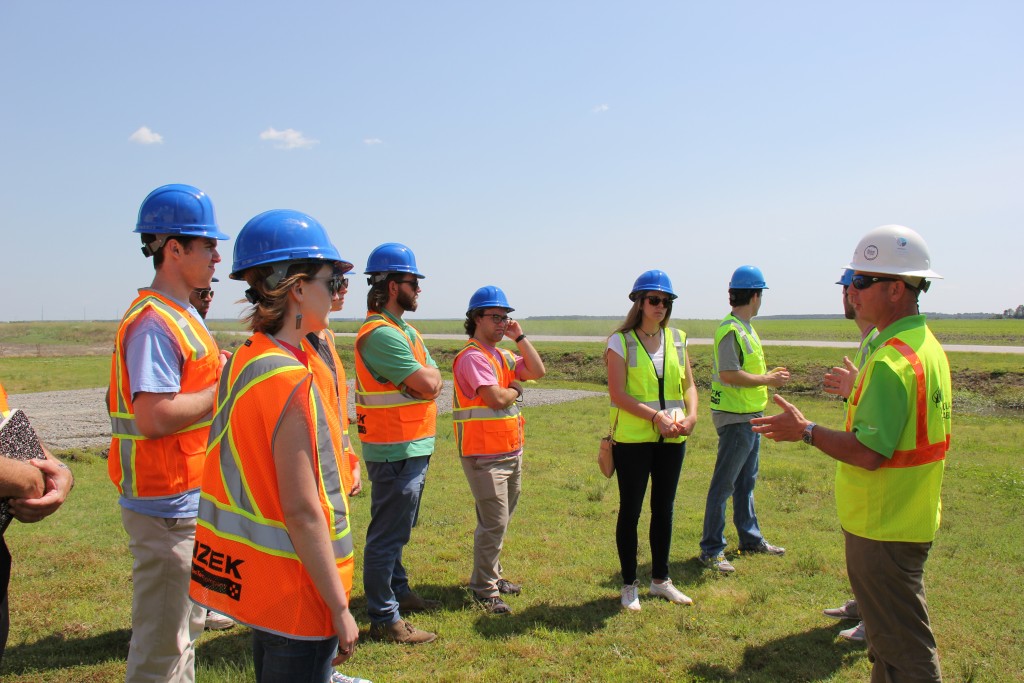
Poff said the first phase of the project, which includes 104 two mega-watt turbines, is currently under construction. The second phase, which consists of 46 turbines along the northern tier of the project, will be built after data is collected from the first 104 turbines and it is determined if the other 46 turbines are necessary or can be cut loose.
At the wind farm, Poff took the class on a tour. He stopped to show them a temporary meteorological tower, which he cited as the first step in assessing a site.
Next, the class stopped at a foundation that was being poured the next day.

After that they stopped at the construction office so the class could see a map of the site. Lastly, the group visited an already poured foundation.
After a long day of being outside, the students and Gangi went to the Pasquotank Government County Office in Elizabeth City to meet with Pasquotank County Attorney Mike Cox. Here the class talked about the role policies played in making Pasquotank County more renewables focused.
Cox listed benefits related to the Amazon Wind Farm, which included: $250,000 per year in tax revenue, $6,000 per year per turbine for landowners, 250 construction jobs, and income for local businesses.
The next day, the class visited Edenton to get an up-close look at the wind turbines which were staged for delivery. As the class entered the site a chorus of “ooo’s” and “ahh’s” sounded from the van. The colossal white turbines lay in four parts on their sides for what seemed like miles.
Poff met the class and talked about turbine design and allowed the class to go inside one of the turbines. There was a quick scramble as students rushed to get a look and walk around inside one of the turbines. Poff explained that the turbines arrived in four parts and will need to be fully constructed.
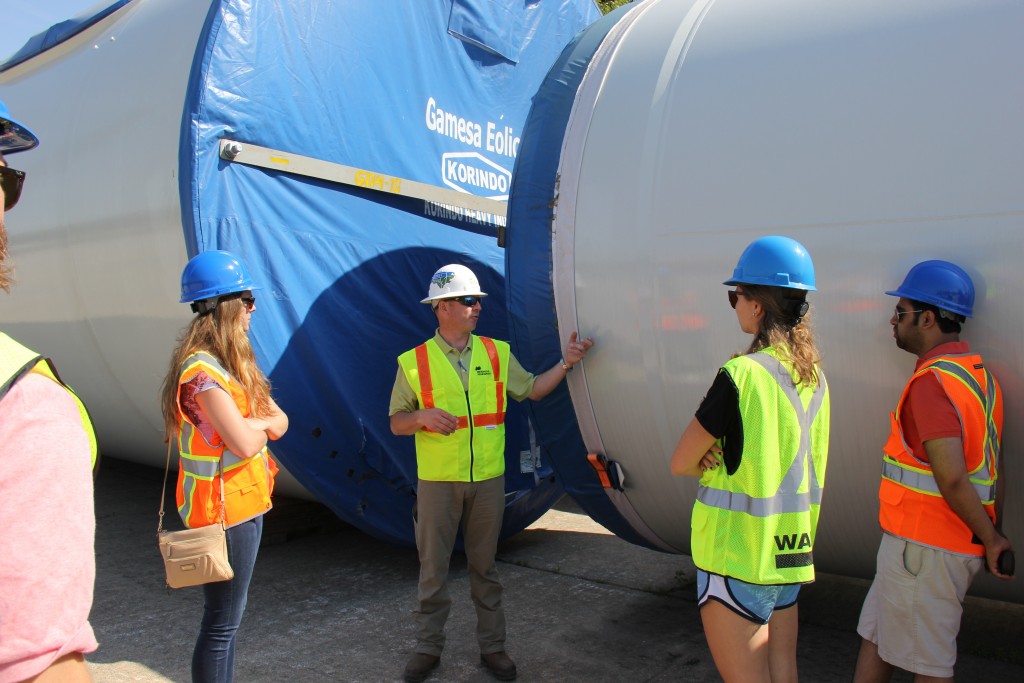
The last stop was the UNC Coastal Studies Institute in Manteo, where the class met with Research Assistant Professor Lindsay Dubbs. The class toured the idyllic coastal institute; a raised, heavily windowed building that sits right on the waters edge. Dubbs also took the class into various laboratories while bringing them up-to date on some of the research being conducted at the coastal institute.
Dubbs focused on the topic of renewable ocean energy and what advances are currently being made in that sector. There is an overall need to pursue renewable energy, Dubbs said, and a benefit to pursuing ocean renewable energy in particular.
“Human populations are concentrated along coasts,” Dubbs said. “Any idea why you would want to locate the generation next to the consumer? Transmission costs and transmission losses. Here in the US we don’t have very many high capacity direct current systems so we have a lot of losses relative to places that use direct current transmission.”
Dubbs then took the class to Jennette’s Pier, a test site for a desalinzation buoy and a platinum leed certified building. The pier was impressively modern and beautiful, clearly a popular spot for fishermen and beach-goers.
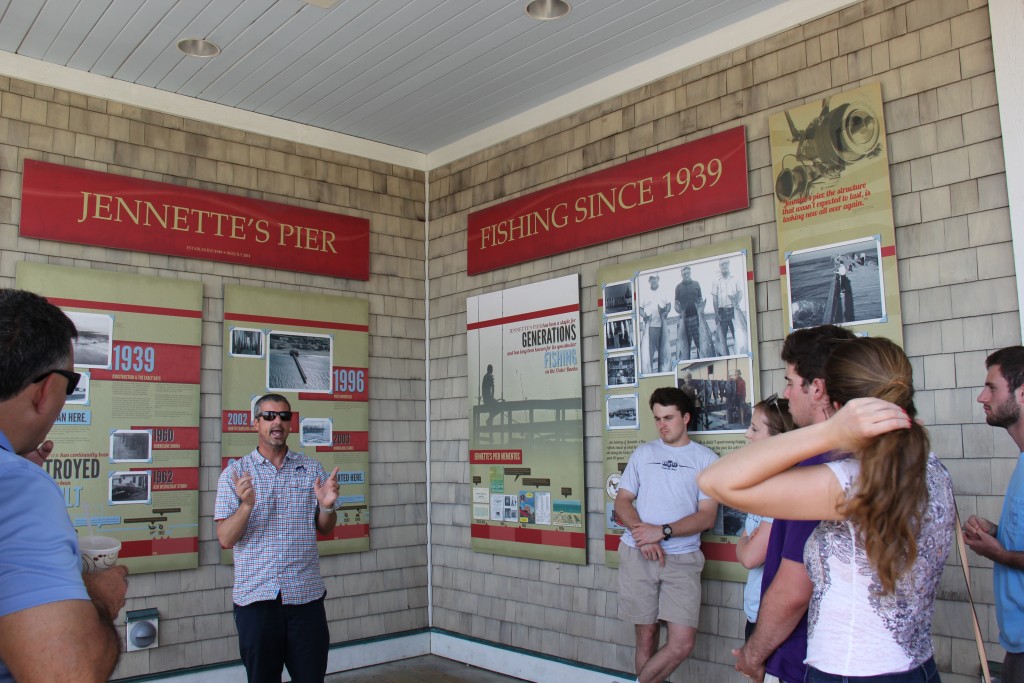
The class talked to Mike Remige, the manager of Jennette’s Pier. Remige talked about what the pier did to achieve a platinum LEED certification. Along with installing wind turbines and solar panels, Remige said the pier had a wastewater treatment and reclamation center, a storm water retention center, and that they focus on education and enabling scientific research.
Aggarwal said he was very impressed with the step Jennette’s Pier took to be more sustainable.
“Jennete’s pier was amazing,” Aggarwal said. “We learned how a simple fishing pier can do such wonders for conservation simultaneously, including 85% water reclamation use, three wind turbines deployed to meet 25% energy needs, and serving as research station, an ocean energy test facility and an education center. It truly was nothing short of a mind-boggling example.”
At Jennette’s Pier the class also met with the Saros team that developed the desalinization buoy and asked questions about where they got their inspiration and how they managed to transition the project from an idea to a product.

As the class began their bus trip home, the students traded favorite moments from the trip and their class.
Morgan Zemaitis, environmental science major and mathematical decision sciences minor, said the class allowed her to visit things she wouldn’t normally have known about or seen.
“It’s nice to have a class where you are focusing on something at a local scale and understanding, for me as a North Carolinian, what is actually happening in my state that I don’t know about that I can drive two hours and see myself if I have that initiative,” Zemaitis said. “Seeing what a huge construction project in taking place in the Eastern North Carolina, the place I vacation, is really cool thing and that I support is happening.

